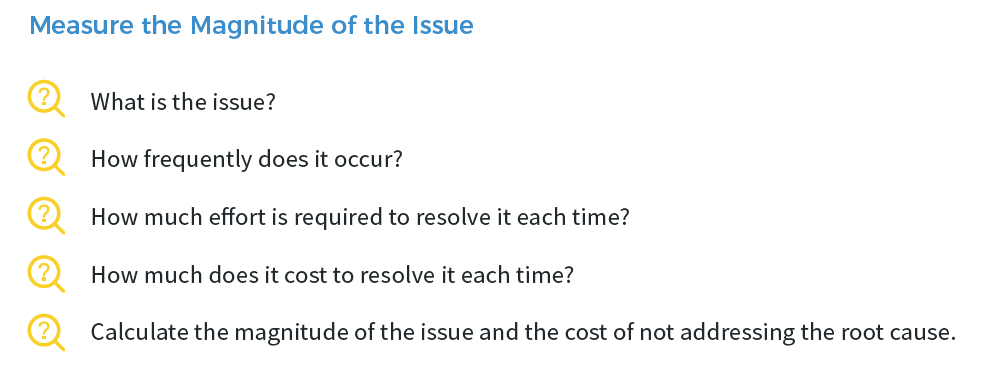Inefficient Processes, Pricing and Failed Customer Experiences
As your organization grows systems and processes become increasingly complex. Are you tracking down the root cause of money leaks and friction in the experiences you provide? The root likely spans teams, functional areas and different technologies. It’s important to start by understanding the quality of the experiences you provide as well as digging deeper into the magnitude and impact of persistent issues.
Seven Types of Waste, plus Non (under) Utilized Talent
Client Story
Our client was a global provider of technology solutions for the restaurant and retail industry and much like the old adage “the cobbler’s children have no shoes”, their technology was a hodgepodge of point solutions held together with duct tape and bailing wire. Their processes had organically morphed over time without much end-to-end review or re-design to introduce automation, improve efficiency, and reduce waste. Their current reality was very manual, time-consuming, inefficient processes, frustrated employees, and a lot of unhappy customers that often went elsewhere next time.
As part of a large, multi-year digital and customer experience transformation, our team dug into their core processes across R&D, marketing, sales, supply chain, assembly, finance, operations, etc. and what the ultimate goal for each was.
Waste is expensive!
One of the processes that seemed to be at the root of a lot pain and waste was for pricing custom product configurations, required to respond to RFPs.
Finance and several from Operations shared all the reasons why the complex, convoluted process was the way it was. 13 areas of the business participated. 21 people involved in order to get custom pricing provided in order for sales to respond to an RFP and win new business.
Sales leadership didn’t care much for the details of the process other than to say they wanted the pricing turned around faster. They needed it faster to try and win the business.
I co-led a series of customer experience workshops; my co-facilitator was a Customer Experience-minded CFO, Robert Nix. There were leaders from many functional areas participating in our workshop. After mapping the current customer journey with clients and highlighting key areas of pain (friction), we reviewed customer verbatims, feedback from customer-facing team members, and key findings from process deep dives.
The participants from the sales side of the business weren't very interested in topics relating to process deep dives into operations and supply chain and only occasionally interested when it came to finance processes, including customer pricing and margin exception requests. They drove the point home that they had to get custom pricing faster to win new business. Our sales leadership participants also noted that competitive custom pricing was also an issue, but nothing could be done to solve for that, since their margins were already razor thin. Hmm…
Prior to this workshop, we spoke with many customer-facing employees, long-term customers, and recently churned customers (our client’s customer) to better understand their needs and priorities. What we heard consistently was about price!
Key Customer Insight: #1 reason they chose a different solution after being long-time customers - PRICE.
My brilliant co-facilitator ever so poignantly commented that all the waste in their inefficient and resource-intense custom pricing process alone ate away at margins, and over a span of 18-24 months resulted in raising custom prices a bit at a time - incrementally, all without realizing better margins.
Moral of the Story: Money leaks (waste) erode your profit margins and/or leads to price increases for customers. Pricing and turnaround time of that pricing is all part of a customer’s experience.
Outside In and Inside Out Vantage Points
With a background in Sales, Marketing, Product Management and Client Program Management, my natural vantage point is a bit more outside in than some others. The value of the outside in vantage point is when it comes together with others steeped in a more inside out vantage point.
Finance and Operations (backstage functions) are inextricably intertwined with the Customers’ Experiences (their perception of everything front stage).
From building a business case for Customer Experience(CX) transformation, to calculating ROI for CX initiatives, and identifying and prioritizing CX improvements, the front-office / back-office, front-stage / back-stage, journey map / solution blueprint, outside in / inside out perspectives must work together to define, design, and delivery great experiences.
Plug money leaks and boost profit margins by elevating experiences. Cross-functional collaboration makes this simple. Not easy but simple.
Where to Start
Begin with these five (5) questions.
Have you purchased your copy of my new book? It’s a short guidebook, and in it I share five key customer experience mistakes organizations make that lead to profit erosion. The above includes excerpts from the accompanying Planning Workbook available at wwww.profiterosion.com.
I wrote the book because these mistakes often go unnoticed—they start as small inefficiencies and multiply throughout the organization as the company's growth accelerates. When you know what mistakes you're making, you can start working to patch the holes and create a stronger customer experience.
Book Available on Amazon ➡️ https://bit.ly/CXbook








